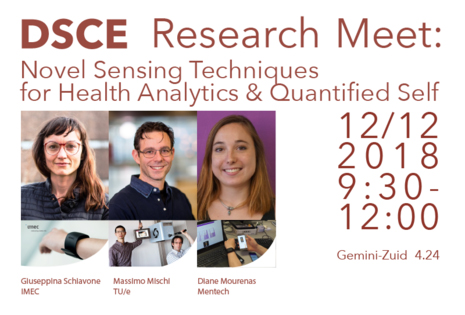Research meet on Novel Sensing Techniques for Health Analytics and Quantified Self
- Datum:
- 12 December
- Tijd:
- 09:30 - 12:00
- Locatie:
- Gemini South 4.24 (TU/e campus)
- Organisator:
- Data Science in cooperation with Center for Humans and Technology

Research Meet for the Research Programs Health Analytics and Quantified Self.
The theme of the event is “Novel Sensing Techniques for Health Analytics & Quantified Self” and we are happy to have a program with a mix of TU/e researchers and external research partners. Both IMEC and Mentech are eager to expand ongoing collaborations.
If you are interested to join, please send us an email (to: Pieter van Gorp)
09:30: Opening by Natal van Riel and Aarnout Brombacher
09:40: Giuseppina Schiavone (IMEC)
10:10: Q&A
10:20: Massimo Mischi (TUE)
10:50: Q&A
11:00: Diane Mourenas (Mentech)
11:30: Q&A
11:40: Announcements, Closing and Networking
12:00: End of Session
- Giuseppina Schiavone is senior researcher and data scientist for the imec.ichange program, in the Connected Health Solutions group at Holst Centre/imec-nl (Eindhoven, Netherlands). Her research focus is to use digital phenotyping (as output of time-series analysis, routine and anomalies detection, unsupervised clustering, deep learning) to link human behaviors and health outcomes in real-life scenarios. Current applications of her research include stress management, smoking dishabituation, treatment of eating disorders.
- Massimo Mischi - The measurement of the muscle activity is a useful procedure both in the clinic and outside. This is because of the variety of muscles that can be investigated and monitored, ranging from striated skeletal muscles up to smooth muscles such as the stomach or the uterus. Muscle activity is typically measured by electromyography (EMG) based on contact electrodes which can sense the biopotentials produced by the muscle cells. These biopotentials, referred to as action potentials, result from ionic currents across the cell membrane and drive muscle contraction. In this lecture, acquisition and analysis of the EMG signal will be presented for assessment and characterization of the activity of both smooth and striated muscles. Striated muscles are analyzed in the context of vibration exercise and characterization of neuromuscular reflex mechanisms, with the aim of advancing rehabilitation programs by efficient neuromuscular conditioning. The analysis of smooth muscles focuses on the uterus with the aim of assessing the risk of preterm birth, which represents a major risk factor in pregnancy. In both cases, dedicated multichannel EMG analysis is developed based on advanced acquisitions by high-density grids of Ag-AgCl electrodes. The signal quality is improved by acquisitions and pre-processing algorithms that are tailored to deal with motion artifacts and power-line interference. The use of contactless capacitive sensors is also being considered and investigated to provide comfortable and unobtrusive solutions for long-term monitoring. The produced large datasets will open up new opportunities for understanding and monitoring the complex processes underlying muscle activity.
- Diane Mourenas - People with limited communication capabilities, like people with a severe mental disability or dementia, are often not capable of expressing their emotions. This leaves these vulnerable people in many cases misunderstood and not always adequately helped. Better understanding of their emotions, feelings and unmet needs will strengthen the trust relation between the client and the caregiver. It will ensure a better care for less costs and ultimately it will lead to increased quality of life and happiness. Mentech Innovation develops sensor based systems that quantify emotions to give these vulnerable people a voice. Thanks to data analytics, Mentech has created a mathematical and statistical model, based on the measurement of electrodermal activity (EDA) and inter-beat intervals (IBI). EDA is an important signal since it is closely related to the activity of the nervous system. The IBIs measurements are used in heart rate variability analysis methodology, as criteria to evaluate the functional state of the organism. Both EDA and IBI are also used in deep-learning algorithms to predict stress.